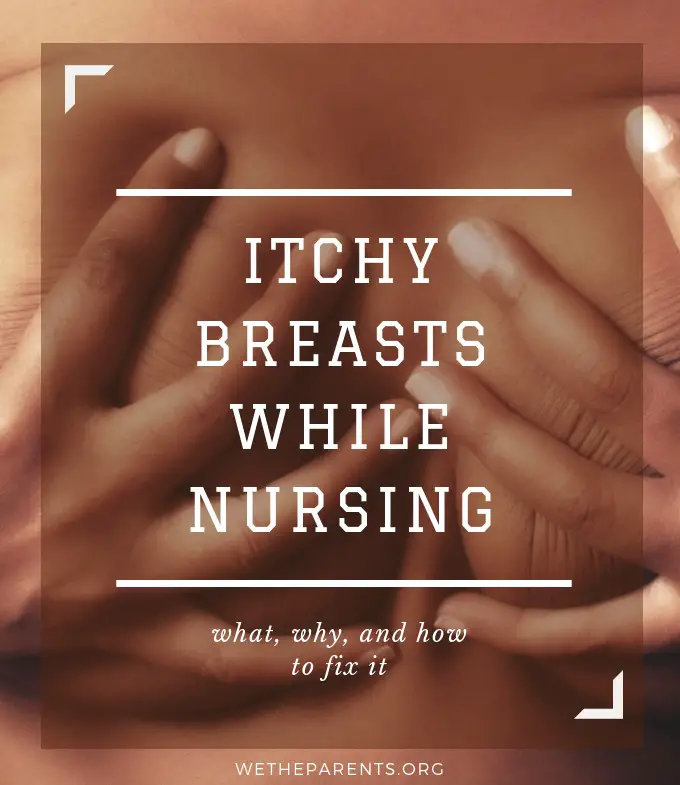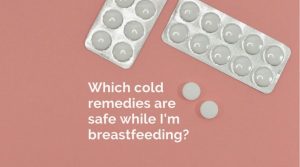Are you sick and tired of having an itchy chest while nursing your baby?
Of course, you are! But do you know how to remedy the issue? We do.
Look, breastfeeding is beautiful, and should never become something that you dread doing. But it’s pretty hard to appreciate the exquisite bonding experience nursing provides when you are focusing all your energy on not scratching your boobs right off your chest!
So, what can induce itchy breasts while breastfeeding and how can you make it better? There are actually several causes, each with their own solutions, ranging from the benign to the ‘it’s-time-to-call-the-OBGYN’, in terms of their seriousness.
In this article:
#1 Stretch marks
As women, our bodies are amazing, strong, and…stretchy. Hey, it’s true, and all mothers have the lines to prove it. Wear ’em loud, wear ’em proud, ladies.
If your breasts are itchy and you can’t figure out a medical reason why, then you might want to consider good old-fashioned stretch marks as the culprit. After all, your belly wasn’t the only thing expanding during your pregnancy, and your breasts are now doubling as a fully stocked, all-you-can-eat buffet.
Why do we get stretch marks?
Stretch marks can form whenever a period of rapid growth or weight gain occurs. When the skin can’t quite keep up, as often happens during pregnancy, you will notice that stretch marks have appeared.
There are many factors that contribute to stretch marks, including genetics and pregnancy hormones, but, simply put, stretch marks occur when there is rapid stretching or shrinking of the body, rupturing the collagen and elastin within our skin. As the skin heals from this injury to its supporting structures, stretch marks appear, similar to a scar.
As with most scars, stretch marks have the potential to become itchy or irritated.1Robinson, M. What Causes Stretch Marks and How to Get Rid of Them.aad.org
How to treat the itch
Since there is no proven treatment for clearing your skin of stretch marks, let’s focus on relieving this annoying symptom.
Many women have found success by:
- Taking a 15-30 minute bath, ensuring that their stretch marks are submerged in cool water mixed with colloidal oatmeal
- Patting the affected area dry when the skin gets wet
- Applying liberal amounts of a preferred moisturizer to the affected area
- Applying ice packs to the affected area
- Avoiding wearing synthetic fabric on the affected area
Whatever you do;
- DO NOT rub the skin with a towel after a bath or shower
- DO NOT scratch.2Pregnancy: Stretch Marks, Itching, and Skin Changes
healthlinkbc.ca/health-topics/aa88316
#2 Milk ejection reflex, aka the let-down
You know that thing that you try really hard to describe but can’t find the words for, so ultimately you just exclaim, “It’s like an itch you can’t scratch but you really, really want to!”, while adding a few garbled sound effects while pointing to your boobs, as though that will clarify everything?
Well, we have good news to assist you with your vocabulary!
You might be experiencing “milk ejection reflex”, colloquially known as a let-down if you:
- Experience itchy breasts while nursing
- Develop a pins-and-needles feeling while nursing
- Experience a sudden sense that your breasts are full. 3The Let Down breastmilkcounts.com/breastfeeding-101/the-let-down/
Why the milk ejection reflex happens
Around the two-minute mark of your baby’s nursing session, you might feel that itchy, buzzy, feeling in your breasts and notice that your baby’s swallowing has become a bit louder or changed in pace.
That’s because your milk is coming down the pipeline, so to speak, as the cells and hormones in your breasts work to ensure an adequate flow for your hungry baby. Some mothers will not experience any feeling from their milk ejection reflex, while others will experience mild to intense symptoms. 4Let-down reflex (milk ejection reflex)
breastfeeding.asn.au/bf-info/early-days/let-down-reflex
The pins and needles feeling of let-down is common and is different from the less common but much more bothersome Dysphoric Milk Ejection Reflex (or DMER).
This condition results in a sudden drop in mood, or an overwhelming feeling of emotional distress or discomfort (often described as shame, guilt, or sadness) as your milk lets down.
It is different from postpartum depression and these feelings normally only last for a few minutes or less before resolving.
There is no treatment other than emotional support, though up until the early 2000s, this condition was rarely talked about and did not have a name.
Promoting awareness and understanding is greatly beneficial for those women who experience it.5Heise, A. M. (2017). Before the Letdown: Dysphoric Milk Ejection Reflex and the Breastfeeding Mother.d-mer.org
How to treat discomfort
Here’s where there’s a mixed bag of news.
The good news is that you might become used to these sensations, to the point where you no longer notice them.
The bad news is that there is technically not a lot to alleviate the issue at the moment. Some mothers have reported easing their symptoms by:
- Relaxing while nursing
- Focusing on their baby
- Applying a warm compress to their breasts. 6Let-down reflex (milk ejection reflex) breastfeeding.asn.au/bf-info/early-days/let-down-reflex
#3 Dry skin
Sometimes, that annoying itch can be explained away by something as simple as dry skin. As we all know, dry skin can itch like no one’s business, but quickly becomes everyone’s business if we’re scratching away at our boobs.
Dry skin can also lead to irritation or cracked nipples, which can, in turn, enhance the chances of contracting an actual infection. It can have quite the domino effect.
Why do we get dry skin
Dry skin can occur for countless reasons. In breastfeeding women these can include:
- Your baby latching on to just your nipple in an improper latching position
- Not drinking enough water
- Using harsh soaps or cleansers
- Not changing. 7Itchy Nipples & Breastfeeding hellomotherhood.com/article/527174-itchy-nipples-breastfeeding/
How to treat dry skin
Even though dry skin can be pervasive and irritating, it is actually one of the more straightforward culprits when dealing with itchy breasts. You will want to:
- Stay hydrated
- Find a nipple cream or lotion that works for you
- Apply your preferred lotion after breastfeeding
- Rub a bit of your own milk on the affected area after breastfeeding. 8Hnilica, K. A., & Patterson, A. P. (2016). Small Animal Dermatology-E-Book: A Color Atlas and Therapeutic Guide.Elsevier Health Sciences.aad.org
Editor’s Note:
Soaps and lotions that are heavily scented should be avoided and non-scented products, designed for sensitive skin, used instead. The ingredients often contained in fragrances can actually be irritating to the skin, only furthering dryness and contributing to itchiness over time.9Hnilica, K. A., & Patterson, A. P. (2016). Small Animal Dermatology-E-Book: A Color Atlas and Therapeutic Guide.Elsevier Health Sciences.
aad.org
#4 Thrush
This fungal infection is about as much fun as…well, itchy, irritated, inflamed, itchy (it deserved another mention) nipples.
Thrush could be the source of your discomfort if you notice:
- An itching and/or burning sensation in your nipples
- Cracks in your nipples
- A ‘shiny’ appearance to your nipples
- Deep breast pain that can range from mild to severe. 10Common breastfeeding challenges womenshealth.gov/breastfeeding/breastfeeding-challenges/common-breastfeeding-challenges
Why thrush happens
Believe it or not, the pathogenic yeast that causes this problem is actually always inside us. When our body isn’t enforcing the house rules, candida, normally a benign internal dweller, can become as out of control as a teenager home alone for the weekend.
In short, it can affect your milk ducts as well as your nipples, as breastmilk is very conducive for candida overgrowth when your immune system is a little below par.
Anyone can contract thrush, but it’s most common among the young, the elderly, and the infirm. You may be at risk of contracting thrush if you:
- Are breastfeeding a baby with oral thrush
- Have recently taken or are on antibiotics
- Have recently taken or are taking Prednisone
- Are diabetic
- Have cancer
- Are anemic
- Are otherwise immunosuppressed. 11Itchy Nipples and Breast-Feeding: Treating Thrush healthline.com/health/parenting/itchy-nipples-while-breastfeeding#3
How to treat thrush
While thrush will not cause long-term harm per se, I think we all agree that all that extra candida needs some reigning in. Luckily there are many options out there, but you need to have your baby checked out for oral thrush, as well. You don’t want your first bonding experiences to include playing candida lacrosse.
Treatment for your baby, which should occur even if she is not symptomatic, will likely be a mild anti-fungal in cream or liquid.
You can try to control your own thrush with an over-the-counter anti-fungal cream, but we always encourage mothers to consult with their doctor before starting any kind of treatment. Your doctor may also:
- Prescribe a specific anti-fungal medication
- Discuss altering your diet
- Suggest Ibuprofen to alleviate breast pain
- Advise you to begin taking a probiotic. 12Itchy Nipples and Breast-Feeding: Treating Thrush healthline.com/health/parenting/itchy-nipples-while-breastfeeding#3
To help prevent a reoccurrence of thrush, it is recommended that you:
- Wash your breasts and nipples daily with soap and water
- Frequently wash your and your baby’s hands
- If using nursing pads, it’s advised that you use disposables that you can change after each feed
- Always wear a clean bra
- Once a day, boil things that may have been exposed to candida (e.g. teething rings, pacifiers, bottle nipples) for twenty minutes
- Boil the parts of your breast pump that have had contact with your milk for twenty minutes every day
While undergoing treatment, you can still breastfeed your baby.13Candida or thrush of the nipple and breast
canadianbreastfeedingfoundation.org/basics/candida_thrush.shtml
#5 Mastitis
Although often the result of an infected breast duct, mastitis can also be caused when milk builds up around the breast tissue. You may experience:
- Itchy, tender, and/or abnormally warm breasts
- Irregular swelling or redness on your breasts
- Soreness in your armpits
- Fever
You are especially at risk if you:
- Have sore or cracked nipples
- Overly favor one breast to nurse
- Are fatigued
- Wear a bra that’s too tight
- Have previously suffered from mastitis.14What is mastitis? healthline.com/health/mastitis
Why mastitis happens
If your mastitis is due to an infection, you likely contracted it due to a crack or small cut on your nipple. This allowed bacteria, most commonly Staphylococcus aureus, to enter your body.
Mastitis can also happen if your baby is not latching properly, or will not nurse out of one breast as often as the other. Ultimately, the milk ducts get clogged up, and milk is allowed to stagnate; left untreated, bacteria will develop and thrive in this milk, and infection will occur.15What is mastitis?
webmd.com/parenting/baby/what-is-mastitis#1
How to treat mastitis
Left untreated, mastitis can become a dire health problem. If worried it could be the cause of your itchy breasts, make an appointment with your doctor.
The good news is that it is very treatable. Your doctor will likely:
- Prescribe antibiotics
- Prescribe Ibuprofen or acetaminophen for the pain and fever
- In rare cases, surgery may be required to drain an infected abscess
You will still be able to breastfeed, as it’s the breast tissue that is affected and not the actual milk.16What is mastitis?
healthline.com/health/mastitis#treatment
Wrapping up
Subtly trying to scratch your nipple in the middle of a grocery store might make for a funny story, but you can’t afford to be continually losing (more!) sleep over itchy breasts.
So go ahead and seek out treatment as soon as you notice symptoms; these are all common issues, and you are not failing at breastfeeding if you develop one of these conditions.
The sooner you nip the problem in the bud the less likely you are to develop further health problems.








